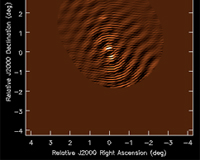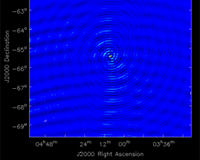ASKAP science commissioning makes progress
 |
 |
14 February 2013
CSIRO's ASKAP science commissioning team has made important progress in testing the telescope's systems since phase closure with three ASKAP phased array feeds was achieved in August 2012.
In November 2012 the team demonstrated single- and multi-beam observations using three phased array feeds and a 16 MHz bandwidth software correlator. The resulting images of 1934-638 (top right), created using short integrations (less than four hours) and three baselines, look just as the team expected.
Since November the beamformers and all digital systems, as well as the observing facilities, have been moved 500 metres from their temporary home near the antennas to the Murchison Radio-astronomy Observatory (MRO) control building. The MRO control building is state-of-the-art infrastructure with two layers of RFI shielding, each in excess of 90 dB.
In late January 2013 the team re-tested the system in its new location. While the team uncovered some hardware bugs, which are currently being resolved, they were able to make a long-track image (bottom right, with an integration of 10 hours) using a single phased array feed beam of the radio source PKS 0407-658 in a single polarisation and a total bandwidth of 16 MHz.
The team was also able to demonstrate remote observing from Boolardy Homestead (approximately 42 km from the MRO control building), which was enabled by remote monitoring of MRO weather data. This is an important step in moving towards fully remote operation of ASKAP.
"These latest test images reflect excellent progress at the MRO and confirm that the telescope's preliminary systems are working as expected," says Ant Schinckel, CSIRO ASKAP Director, of the latest ASKAP science commissioning activities.
The ASKAP science commissioning team is working through a detailed plan for integrating and testing the Boolardy Engineering Test Array (BETA), the first six ASKAP antennas equipped with first-generation phased array feeds and a hardware correlator 300 MHz bandwidth and 36 beams). BETA is expected to be fully assembled by mid 2013. The current interim BETA system has three antennas fitted with first-generation phased array feeds and an interim software correlator (16 1-MHz channels and up to four independent beams).
The next steps for the commissioning team include making a multi-beam image with three phased array feeds and setting up remote observing capability in the new Science Operations Centre at CSIRO Astronomy and Space Science headquarters in Sydney.
Read more on the science that will be done with ASKAP.
Back to Latest ASKAP News page.
